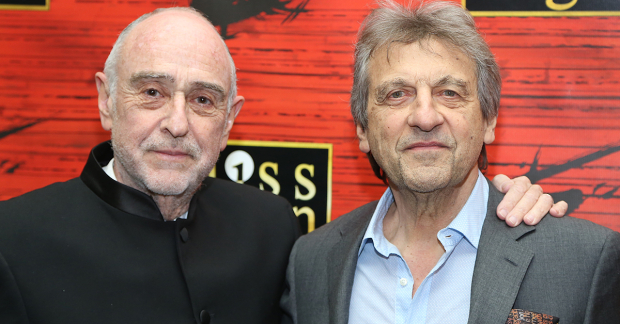Twenty-Five Years Later, a Post-Mort on Boublil and Schönberg's Martin Guerre
It could have been the next ”Les Mis” — but times and styles had changed before this show took the stage.

(© Tricia Baron)
Few musical theater writers have ever pulled off a hat trick — that is, three supremely successful premieres in a row. Rodgers and Hammerstein were stymied by Allegro after Oklahoma! and Carousel. Andrew Lloyd Webber's Jeeves, following Joseph and the Amazing Technicolor Dreamcoat and Jesus Christ Superstar has been a thorn in his side since 1975. Not even Stephen Sondheim has achieved a string of three shows that proved both financially and critically successful.
In the late 1990s, Claude-Michel Schönberg and Alain Boublil were on the precipice of wearing the triple crown. Their first collaboration, Les Misérables, became a worldwide sensation after its premiere in 1985; their next show, Miss Saigon, broke ticket sale records in both London and New York. In 1995, they announced their third project, a modern operetta based on a famous French case of identity theft. Titled Martin Guerre, the protagonist was not unlike Les Misérables Jean Valjean, and the doomed romance at the center echoed that of Kim and Chris in Miss Saigon.
By relying on the tropes that had launched them to success in the first place, it seemed that Schönberg and Boublil were positioned to achieve an unprecedented third smash hit. Instead, what resulted was a musical that has gone through two decades of rewrites and abandoned productions. Twenty-five years ago today, the first revision opened on the West End and one question still remains: What went wrong?
Martin Guerre was Boublil and Schönberg's first serious historical adaptation, and also the first time either had created the supportive structure of a show. Their two preceding musicals had been based on source material created by Victor Hugo and Giacomo Puccini, respectively, while an earlier collaboration, a rock opera called La Révolution Française, was a fictional love story set amid the French Revolution. The historical account of Martin Guerre is incredibly dense, with contradictory tangents littered throughout court documents and personal recollections. The story became famous specifically for its confounding questions, and historians have fought over various interpretations for centuries. Inadvertently, Schönberg and Boublil had selected source material that had been abandoned by many before them for being too overwrought and complicated to craft into a cohesively satisfying story.
When they first presented the piece to their producing partner Cameron Mackintosh in 1990, he turned it down, insisting that they make dramatic revisions to the piece in order to position Guerre as an epic hero in the face of religious intolerance, instead of a common man who falls victim to identity theft. After six years of revisions, which changed the location, timeline, and characterizations of the original story, Mackintosh agreed to a West End staging in 1996.
Directed by Declan Donnelon with all of the extravagant splendor that had come to be expected from a Schönberg and Boublil piece, critics lambasted the production as unfocused, hard to follow, and worst of all, dull. Mackintosh was horrified to have a show described as boring, and efforts were quickly put in place to rewrite the show from the ground up. While still titled Martin Guerre, the focus was shifted to the character's wife, Bertrande. New scenes and songs were added, and a completely new conclusion was devised, independent from the historical record in favor of sending the audience home with a happy ending. This revised version reopened on November 11, 1996, to sufficiently improved reviews, and Martin Guerre went on to win the Olivier Award for Best Musical and Best Choreography for Bob Avian.
However, the team was still unhappy with their final product. Martin Guerre closed on the West End in 1998, after 675 performances, and within a year, Schönberg and Boublil had once again substantially reworked the libretto, score, and lyrics for a new production at the West Yorkshire Playhouse and subsequent UK tour. They returned to the drawing board again in preparation for an American tour that began at the Guthrie Theatre, softening the characters' religious xenophobia and once again reordering the songs. It is estimated that more than 40 percent of the American version was not present in the second iteration of the West End run.
A common thread throughout reviews, both professional and from audience members, was that every iteration had felt hollow. There was no driving force to the production and no reason to care for any of the characters beyond the show explicitly telling you that you are supposed to. The music became increasingly homogeneous with every rewrite, and anything that challenged an audience member was excised in favor of an easy-to-swallow but flavorless evening of melodrama.
Starring Hugh Panaro, Erin Dilly, and Stephen R. Buntrock, the tour played five venues before shuttering, and a teased Broadway transfer was abandoned. It marked the end of the mega musical as we then knew it — a fall from grace so protracted and painful that Schönberg and Boublil have never fully recovered. Their 2006 musical The Pirate Queen suffered a similar fate, and 2008's Marguerite closed after less than four months on the West End. The stylistic flourishes that had tantalized their adoring crowds in the 1980s were undercooked and cliché by 1996, and the theatrical populace had moved on, looking toward pop/rock oriented scores and nostalgia-fueled adaptations instead of the classically adapted modern operas.
One of the reasons the theatrical hat trick has remained unattainable is the very nature of success in the commercial theater. When a production becomes a generation-defining triumph, it is only natural that others will be inspired by it. These trends burn bright and fast, sating audience members' hunger for more over the course of only a handful of seasons. If creatives work quickly, they can perhaps write two pieces within a trend cycle in order to capitalize on the craving. Once the trend ends, the audience moves on, and if the creatives do not reinvent themselves, they too are left behind in the memory of the consumer.
Schönberg and Boublil have continued to tinker with Martin Guerre. In 2016, the duo was striving to mount a reimagined concert production, but in January 2017, Cameron Mackintosh pulled out completely, ending their once prosperous triad once and for all. The score has gone on to be something of a cult classic for musical-theater fans, and its development has become an important lesson for creative teams at the beginning of their careers in the commercial sphere: there is no such thing as a sure thing, and all trends come to an end.








